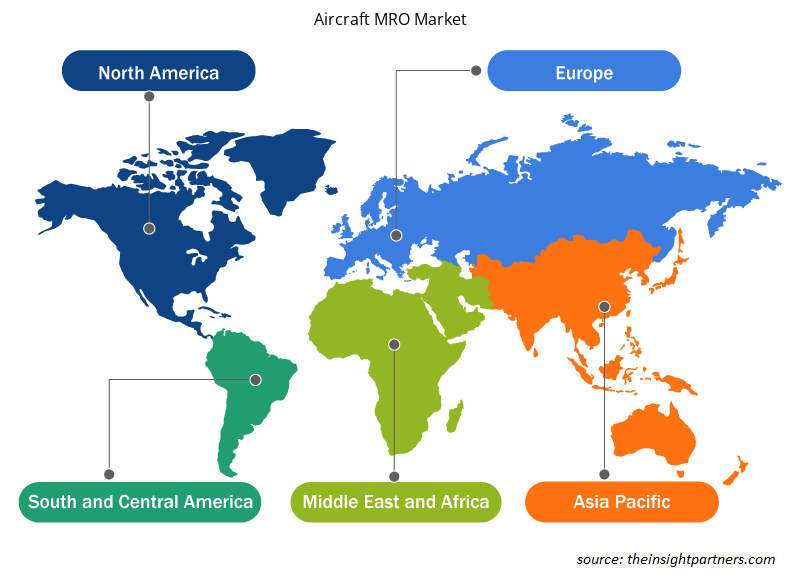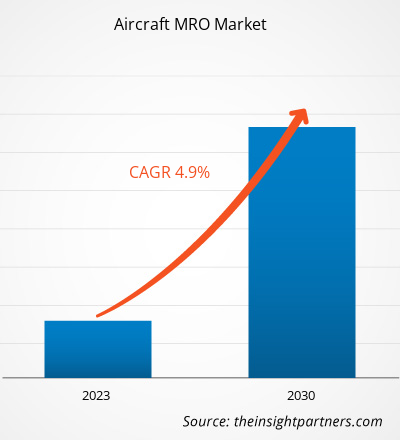预计到2031年,飞机MRO市场规模将从2024年的990.8694亿美元增至1704.829亿美元。预计2025年至2031年期间,该市场的复合年增长率将达到8.5%。区块链技术正在改变MRO格局,并可能在未来几年引领市场新趋势。
飞机MRO市场分析
由于全球中产阶级不断壮大,航空业正在增长并将继续增长。根据国际航空运输协会 (IATA) 2025 年 1 月发布的报告,航空业在 2024 年经历了显著反弹,以收入客公里 (RPK) 衡量的全年总客运量较 2023 年增长 10.4%,比疫情前水平高出 3.8%。这一增长得益于国际和国内旅行的强劲增长,其中国际客运量增长了 13.6%,国内客运量增长了 5.7%。以可用座位公里 (ASK) 衡量的总运力也显著增长了 8.7%,使全年载客率达到创纪录的 83.5%。中国民航局 (CAAC) 计划到 2035 年新建 216 个机场,以满足日益增长的航空旅行需求,这将对飞机 MRO 市场产生直接的积极影响。
推动全球飞机MRO市场增长的主要因素包括航空旅行的增加、新兴经济体MRO服务提供商的崛起以及数字技术在MRO行业的日益融合。根据Insight Partners的分析,2025年1月全球商用飞机队规模约为2.9万架,到2035年底可能达到约3.83万架。同样,2024年全球航空客运量约为95亿人次,与2023年全球航空客运量相比增长约10%。此外,2024年的航空客运量相当于2019年水平的104%,已全面恢复至疫情前的水平。
飞机MRO市场概览
近年来,航空业的快速发展增加了对航空公司 MRO 服务的需求。新兴经济体,例如亚太地区的经济体,高度重视将 MRO 服务扩展到商用和军用飞机公司。亚太地区的主要飞机 MRO 企业包括中国广州飞机维修工程有限公司 (GAMECO)、MTU 维护公司和宜捷海特航空服务中国有限公司。航空基础设施建设的大量投入、经济增长和旅客数量的增加是推动飞机维护服务普及的因素。此外,中产阶级旅行者数量的激增,尤其是在中国、新加坡和印度等亚太国家,是推动航空旅行增长的主要因素,从而增加了该地区对飞机维护服务的需求。亚太地区其他国家,包括新加坡、马来西亚和泰国,由于拥有完善的 MRO 枢纽,从航空 MRO 市场获得了大量收入。例如,新加坡凭借其成熟的MRO枢纽,在亚太其他地区占据主导地位,通用电气航空、空客和劳斯莱斯等主要市场参与者在新加坡都拥有大量业务。根据威斯康星州经济发展局 (WEDC) 的数据,新加坡拥有120家航空航天公司,占据了亚太地区MRO市场的四分之一份额。
- 2025年,赛峰电子与防务公司宣布扩大在印度的业务,在班加罗尔开设一个新的电子卡和航空航天及防务计算器生产基地,以及一个新的电子研发中心。
- 2024年,赛峰集团宣布将在印度海得拉巴建造其最大的MRO设施之一。
- 2025 年,泰雷兹公司在新德里机场附近的古尔冈开设了新的航空电子设备 MRO 设施。
- 2023 年,普惠公司和三菱重工航空发动机有限公司宣布在日本建立第二家运营的 GTF MRO 工厂。
此类机构以及现有 MRO 设施在新兴地区的扩张进一步推动了飞机 MRO 市场的增长。
您可以免费定制任何报告,包括本报告的部分内容、国家级分析、Excel 数据包,以及为初创企业和大学提供优惠和折扣
飞机MRO市场:战略洞察

- 获取此报告的顶级关键市场趋势。此免费样品将包括数据分析,从市场趋势到估计和预测。
飞机MRO市场驱动因素和机遇
数字技术在MRO行业日益融合
鉴于全球竞争日益激烈,数字技术的实施是MRO公司发展的必要一步;这有助于他们在供应链的各个层级创建连续的数据流,进一步简化利益相关者之间的沟通,并加速各项运营的创新。航空业的数字化革命对航空业供应链的所有领域都产生了重大影响,包括飞机运营、空中交通管理以及飞机和零部件的制造和服务。数据分析等数据驱动技术有助于实时跟踪飞机MRO活动,也将优化机组人员和乘客的航空旅行体验。其他先进技术,如人工智能和机器学习,有助于航空公司机组人员和管理层了解飞机的适航性。此外,MRO服务提供商采用人工智能技术,通过轻松高效地进行目视检查并了解飞机所需的维护和维修程度来改进其流程。因此,人工智能和机器学习等数字技术的日益融合推动了飞机MRO市场的发展。
旧型飞机队的改装
改装是指在老旧飞机机队上安装或添加新技术,这有助于提高乘客的舒适度和安全性,并方便航空公司维护其老旧机队。飞机技术的不断进步促进了MRO能力的提升。MRO服务提供商不断寻求升级和采购新技术,以便为新飞机提供服务,并为老旧机队改装升级后的技术。在当前形势下,由于燃油价格下跌,全球商业航空公司仍在保留其老旧机队。这一因素迫使航空公司频繁选择MRO活动,这促使MRO服务提供商为航空公司提供使用新技术改装机队的服务。MRO服务提供商中的改装趋势正在飙升。因此,将先进的现代技术融入老旧机队预计将改变飞机MRO市场格局以及航空业的面貌。
飞机MRO市场报告细分分析
飞机MRO市场分析的关键细分领域包括部件、飞机部件和最终用户。根据部件,市场细分为发动机MRO、航空电子设备MRO、机身MRO、客舱MRO、起落架MRO等。发动机MRO领域在2024年占据最大市场份额。按飞机类型,市场分为固定翼飞机和旋翼飞机。2024年,固定翼飞机占据了更大的市场份额。此外,根据最终用户,市场分为商用和军用。2024年,商用飞机占据了更大的市场份额。
飞机MRO市场份额(按地区)分析
飞机 MRO 市场报告的地理范围分为五个主要区域:北美、欧洲、亚太、中东和非洲以及南美。亚太地区在 2024 年占据最大的市场份额,为 39.1%,预计在预测期内的复合年增长率为 9.9%。全球航空客运量持续增长,这迫使航空公司增加航班起降并引进新飞机。飞机 MRO 活动对于保持部件的可用性、一致性和质量至关重要。航空公司运营商依靠 MRO 服务来确保飞机安全并提高燃油效率。由于原始设备制造商 (OEM) 主要专注于飞机研发,MRO 市场已成为航空业一项可行的业务。在世界大多数地区,过去几年经济表现显著,主要原因是消费者购买力增强、股市不断增长以及行业整合。尽管存在英国脱欧和其他各种贸易壁垒,但全球市场仍保持相对稳定。
2024年12月,整体需求同比增长8.6%,载客率达到84%,表现强劲,进一步凸显了航空旅行的持续复苏和日益增长的需求。持续的需求可能会推动航空公司加大对机队的投资,从而导致MRO合同数量增加,因为它们力求保持运营效率并遵守安全法规。
此外,MRO供应商的资本支出有所增加,例如达美航空技术运营公司(Delta TechOps)签订了九份价值2.25亿美元的新零部件合同,这反映出航空业已做好充分准备,以满足日益增长的需求。随着航空公司不断采用下一代飞机对机队进行现代化升级,MRO供应商需要提升自身能力,并投资于先进技术,以支持这些机型。
飞机MRO市场区域洞察
Insight Partners 的分析师已详尽阐述了预测期内影响飞机 MRO 市场的区域趋势和因素。本节还讨论了北美、欧洲、亚太地区、中东和非洲以及南美和中美的飞机 MRO 市场细分和地理分布。

- 获取飞机MRO市场的区域特定数据
飞机MRO市场报告范围
| 报告属性 | 细节 |
|---|---|
| 2024年的市场规模 | 990.9亿美元 |
| 2031年的市场规模 | 1704.8亿美元 |
| 全球复合年增长率(2025-2031) | 8.5% |
| 史料 | 2021-2023 |
| 预测期 | 2025-2031 |
| 涵盖的领域 | 按组件
|
| 覆盖地区和国家 | 北美
|
| 市场领导者和主要公司简介 |
|
飞机MRO市场参与者密度:了解其对业务动态的影响
飞机MRO市场正在快速增长,这得益于终端用户需求的不断增长,而这些需求又源于消费者偏好的不断变化、技术进步以及对产品优势的认知度不断提升等因素。随着需求的增长,企业正在扩展产品线,不断创新以满足消费者需求,并抓住新兴趋势,从而进一步推动市场增长。
市场参与者密度是指特定市场或行业内企业或公司的分布情况。它表明特定市场空间内竞争对手(市场参与者)的数量相对于其规模或总市值而言。
在飞机 MRO 市场运营的主要公司有:
- AAR公司
- 巴恩斯集团
- 通用电气航空航天
- FLTechnics,UAB
- 土耳其技术公司
- 新加坡科技工程有限公司
免责声明:以上列出的公司没有按照任何特定顺序排列。

- 获取飞机 MRO 市场主要参与者概览
飞机MRO市场新闻及最新发展
飞机MRO市场的评估是通过收集一手资料和二手资料后进行的定性和定量数据进行的,这些数据包括重要的企业出版物、协会数据和数据库。飞机MRO市场的一些发展情况如下:
- 普惠公司(RTX,纽交所代码:RTX)旗下子公司普惠公司与新西兰航空共同举行了基督城发动机中心扩建工程的奠基仪式,该中心斥资1.5亿美元,占地1.4万平方米。此次扩建将增强新西兰普惠GTF发动机的维护、维修和大修(MRO)能力,预计到2032年,每年可完成多达140台GTF发动机的大修。(RTX,新闻稿,2024年)
- 领先的飞机维护、维修和大修 (MRO) 服务提供商莱茵航空服务有限公司 (RAS) 宣布与汉莎技术航空阿尔泽有限公司 (LTAA) 建立战略合作。LTAA 是一家全球知名的 MRO 服务提供商,专注于区域飞机发动机,是汉莎技术集团和汉莎集团的骄傲成员。(莱茵航空服务有限公司,新闻稿,2024 年)
- 中国东方航空旗下子公司东方航空技术有限公司(EASTEC)与汉莎技术公司签署了一份为期十二年的独家维护服务协议,该协议涵盖了对中国东方航空所有空客A350机队辅助动力装置(APU)的技术支持。根据这份长期合同,汉莎技术公司将在其位于德国汉堡的专业APU维修中心为该机型的霍尼韦尔HGT1700 APU提供全面的维护、修理和大修(MRO)服务。(东方航空技术公司,新闻稿,2025年)
飞机MRO市场报告覆盖范围及交付成果
《飞机 MRO 市场规模和预测(2021-2031 年)》报告对以下领域进行了详细的市场分析:
- 飞机 MRO 市场规模以及全球、区域和国家层面涵盖的所有关键细分市场的预测
- 飞机 MRO 市场趋势以及市场动态,例如驱动因素、限制因素和关键机遇
- 详细的波特五力模型和 SWOT 分析
- 飞机 MRO 市场分析涵盖主要市场趋势、全球和区域框架、主要参与者、法规和最新市场发展
- 行业格局和竞争分析,包括市场集中度、热图分析、知名参与者的市场份额分析以及飞机 MRO 市场的最新发展
- 详细的公司简介
- 历史分析(2 年)、基准年、预测(7 年)及复合年增长率
- PEST和SWOT分析
- 市场规模、价值/数量 - 全球、区域、国家
- 行业和竞争格局
- Excel 数据集
近期报告
客户评价
购买理由
- 明智的决策
- 了解市场动态
- 竞争分析
- 客户洞察
- 市场预测
- 风险规避
- 战略规划
- 投资论证
- 识别新兴市场
- 优化营销策略
- 提升运营效率
- 顺应监管趋势




















 获取免费样品 - 飛機MRO市場
获取免费样品 - 飛機MRO市場